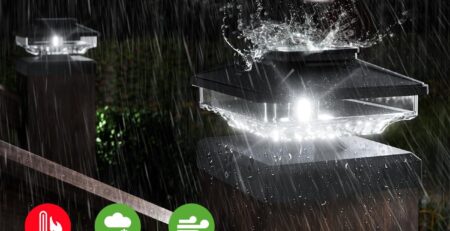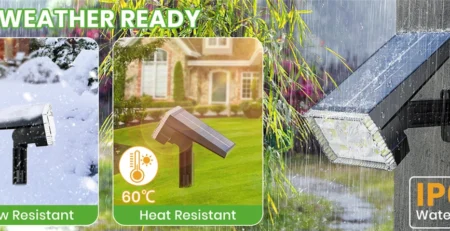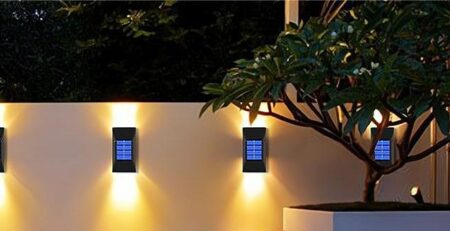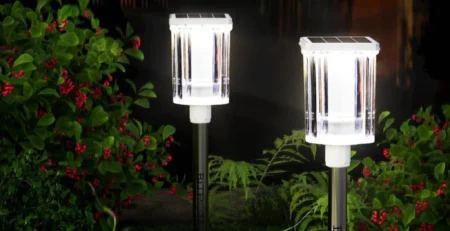Smart Solar Lights for Home Energy Efficiency
Smart solar lights are revolutionizing how homeowners manage energy, especially for those invested in smart home technology and sustainable living. Designed to integrate seamlessly with home microgrids, these innovative lights offer two-way charging, real-time energy tracking via apps, and automatic peak-valley switching to optimize electricity costs. Tailored for smart home users and energy management enthusiasts, this article explores the features, benefits, and practical applications of smart solar lights, complete with an installation guide for pairing with systems like the Tesla Powerwall.
-1-1024x400.webp)
The Role of Smart Solar Lights in Home Energy Systems
Smart home technology thrives on efficiency, connectivity, and sustainability. As homeowners increasingly adopt renewable energy solutions, smart solar lights have emerged as a key component in home microgrids. Unlike traditional solar lights, these advanced models not only provide illumination but also contribute to a home’s energy ecosystem by feeding surplus power into storage systems and drawing electricity when needed. This dual functionality makes them ideal for energy-conscious households looking to reduce reliance on the grid.
Key advantages include:
- Energy Efficiency: Harnesses solar power to minimize grid electricity use.
- Integration: Syncs with home microgrids for seamless energy flow.
- Smart Features: App-based monitoring and automated energy switching.
- Cost Savings: Optimizes electricity use during peak and off-peak hours.
For smart home users, these lights offer a practical way to enhance energy management while maintaining convenience and eco-friendliness.
Two-Way Charging: Powering Your Home Microgrid
Daytime Charging for Energy Storage
Smart solar lights with two-way charging are designed to do more than illuminate. During the day, their high-efficiency solar panels (typically 10-15W) capture sunlight and convert it into electricity. Instead of storing all energy in the light’s internal battery, these models can feed surplus power into a home’s energy storage system, such as the Tesla Powerwall or Enphase IQ Battery. For example, a single smart solar light like the Philips Hue Solar Outdoor can generate up to 12W, contributing small but meaningful amounts to your home’s energy reserves.
Nighttime Power Draw from Storage
At night, these lights can draw power from the home’s energy storage system, ensuring consistent illumination without draining their internal batteries. This two-way energy flow creates a balanced system where solar lights act as both producers and consumers within the microgrid. The result is a more efficient use of stored energy, reducing the need for grid electricity during high-demand periods.
Benefits of Two-Way Charging
- Maximized Energy Use: Surplus solar energy is stored rather than wasted.
- Reliability: Ensures lighting availability even on cloudy days.
- Scalability: Multiple lights can contribute to a larger microgrid system.
This feature makes smart solar lights a valuable addition for homeowners aiming to optimize their energy storage systems.
Energy Usage Tracking: Monitor and Optimize via App
Real-Time Energy Data
Modern smart solar lights, such as the LIFX Solar Smart Lantern, come equipped with app-based energy tracking. These apps display daily power generation and consumption for each light, allowing homeowners to monitor their contribution to the microgrid. For instance, a single light might generate 0.05-0.1 kWh daily, which can add up significantly when multiple units are installed. Apps also provide insights into battery health and charging efficiency, helping users make informed energy decisions.
Optimizing Home Energy Allocation
By analyzing app data, homeowners can adjust their energy usage patterns. For example, if a light consistently generates excess power, you might redirect that energy to charge other devices or power low-energy appliances. This level of control is particularly appealing to energy management enthusiasts who want to fine-tune their home’s energy ecosystem.
Practical Applications
- Budgeting: Track energy savings to reduce electricity bills.
- Maintenance Alerts: Receive notifications for low battery or panel efficiency issues.
- Custom Schedules: Set lighting schedules based on energy availability.
With app-based tracking, smart solar lights empower users to take control of their home’s energy flow.
Peak-Valley Switching: Smart Energy Cost Savings
Leveraging Time-of-Use Rates
Many utility companies charge higher rates during peak demand hours (e.g., evenings) and lower rates during off-peak times (e.g., late night). Smart solar lights with peak-valley switching automatically prioritize solar or stored energy during peak hours, reducing reliance on costly grid electricity. For example, the Ring Solar Pathlight integrates with smart home systems to switch power sources based on time-of-use schedules.
How It Works
These lights connect to your home’s energy management system via Wi-Fi or Zigbee protocols. During peak hours, they draw from the microgrid’s stored solar energy. During off-peak hours, they recharge from the grid if needed, ensuring cost efficiency. This automation is seamless, requiring no manual intervention, and aligns with the needs of smart home users who value convenience.
Benefits for Homeowners
- Cost Reduction: Save on electricity bills by avoiding peak rates.
- Eco-Friendly: Maximize renewable energy use during high-demand periods.
- Automation: No need to manually adjust settings for optimal savings.
Peak-valley switching makes smart solar lights a strategic tool for managing household energy costs.
Choosing the Right Smart Solar Light for Your Home
Key Features to Prioritize
When selecting smart solar lights, consider features that align with your energy management goals:

- Power Output: 10-15W panels for meaningful microgrid contribution.
- Connectivity: Wi-Fi or Zigbee for app integration and automation.
- Battery Capacity: At least 2000 mAh for reliable nighttime operation.
- Durability: IP65 or higher ratings for weather resistance.
- Smart Features: Energy tracking, peak-valley switching, and customizable modes.
Top Recommendations for 2025
- Philips Hue Solar Outdoor Motion Sensor
- Features: 12W panel, 350 lumens, app-controlled, peak-valley switching.
- Best For: Smart home integration and energy tracking.
- Price: Approx. $80.
- Bitpott Solar Pathlight
- Features: 10W panel, motion detection, Zigbee compatibility.
- Best For: Driveway lighting and microgrid integration.
- Price: Approx. $60.
- LIFX Solar Smart Lantern
- Features: 15W panel, 400 lumens, app-based energy monitoring.
- Best For: High-output lighting and data-driven energy management.
- Price: Approx. $100.
- EcoFlow Solar Smart Spotlight
- Features: 13W panel, two-way charging, weatherproof design.
- Best For: Robust microgrid contribution and outdoor durability.
- Price: Approx. $90.
Installation and Maintenance Tips
- Positioning: Install lights in areas with direct sunlight for optimal charging.
- Connectivity: Ensure a strong Wi-Fi or Zigbee signal for app functionality.
- Cleaning: Wipe solar panels monthly to maintain efficiency.
- Updates: Keep firmware updated for new features and security.
Maximizing Energy Efficiency with Smart Solar Lights
Smart solar lights are a cornerstone of modern home energy management, offering a blend of sustainability, convenience, and advanced technology. By integrating with home microgrids, these lights provide two-way charging, real-time energy tracking, and automated peak-valley switching to optimize electricity use. Whether you’re powering your lights with a Tesla Powerwall or another storage system, these devices enhance your home’s energy efficiency while reducing costs.
For energy management enthusiasts, the ability to monitor and adjust energy flow via apps adds a layer of control that traditional lighting can’t match. The included installation diagram simplifies setup, ensuring compatibility with mainstream microgrid systems. By choosing models like the Philips Hue Solar Outdoor or LIFX Solar Smart Lantern, you can transform your home’s outdoor lighting into a dynamic component of your energy ecosystem.
Ready to elevate your smart home with sustainable lighting? Invest in smart solar lights today and take control of your energy future.




-1-3-450x231.webp)






Leave a Reply